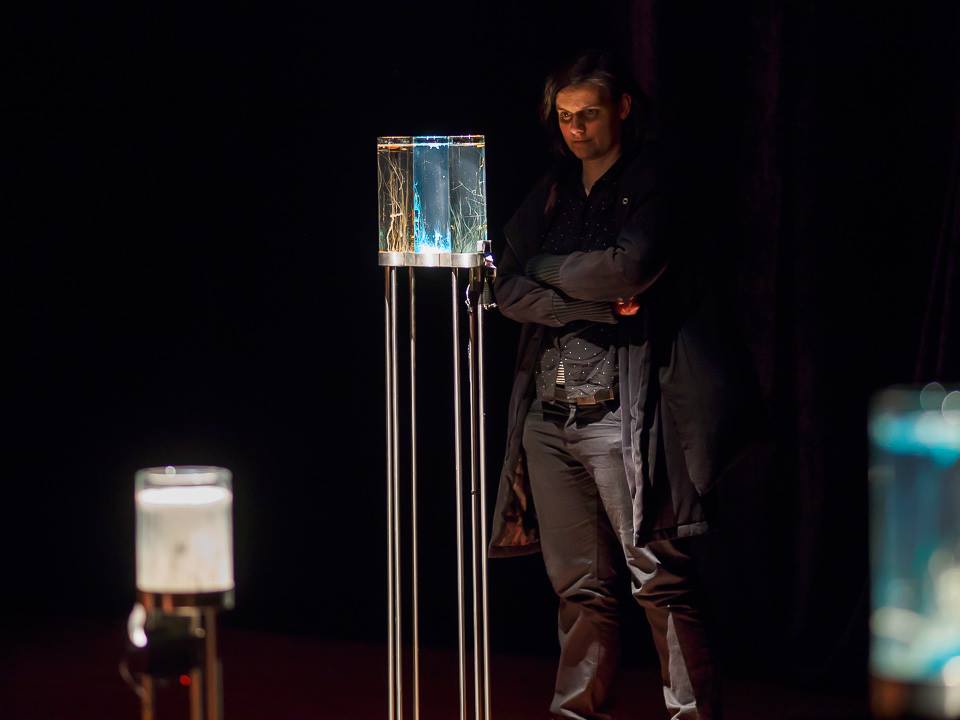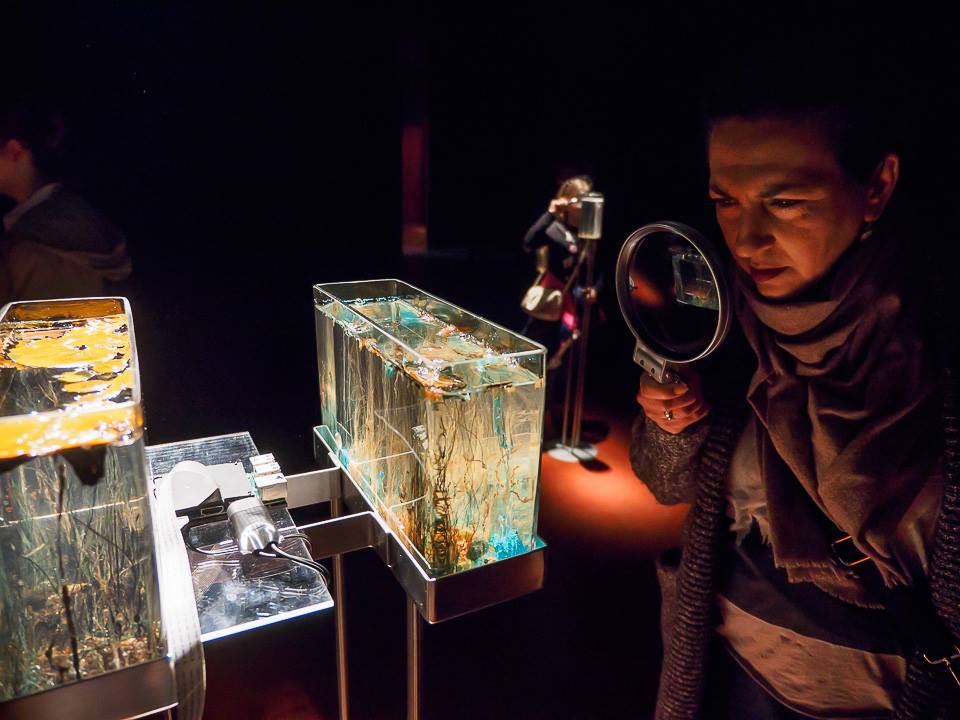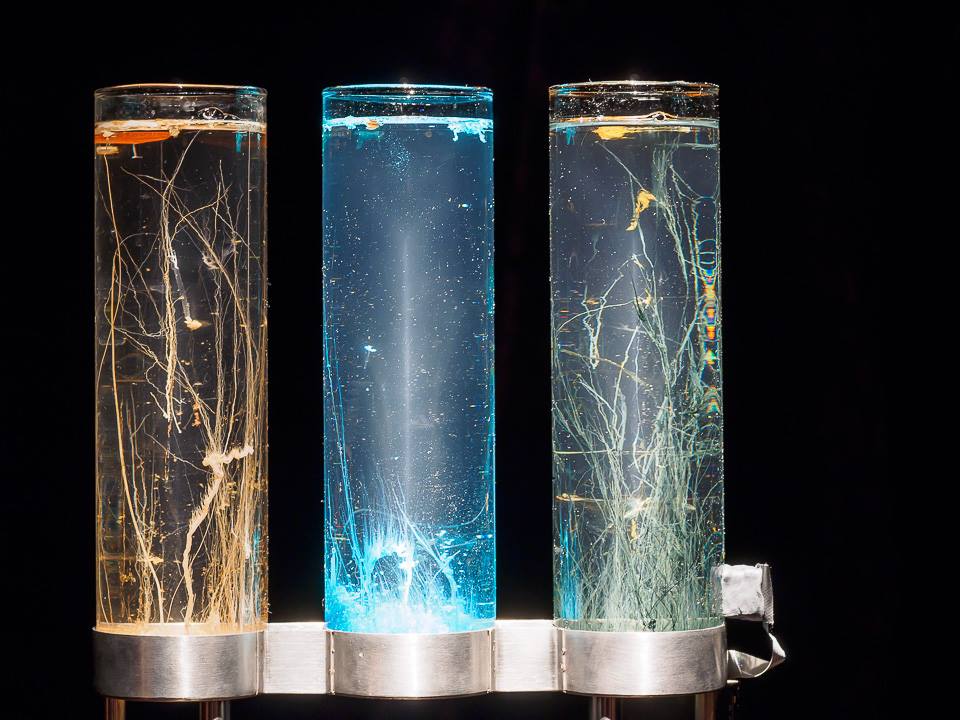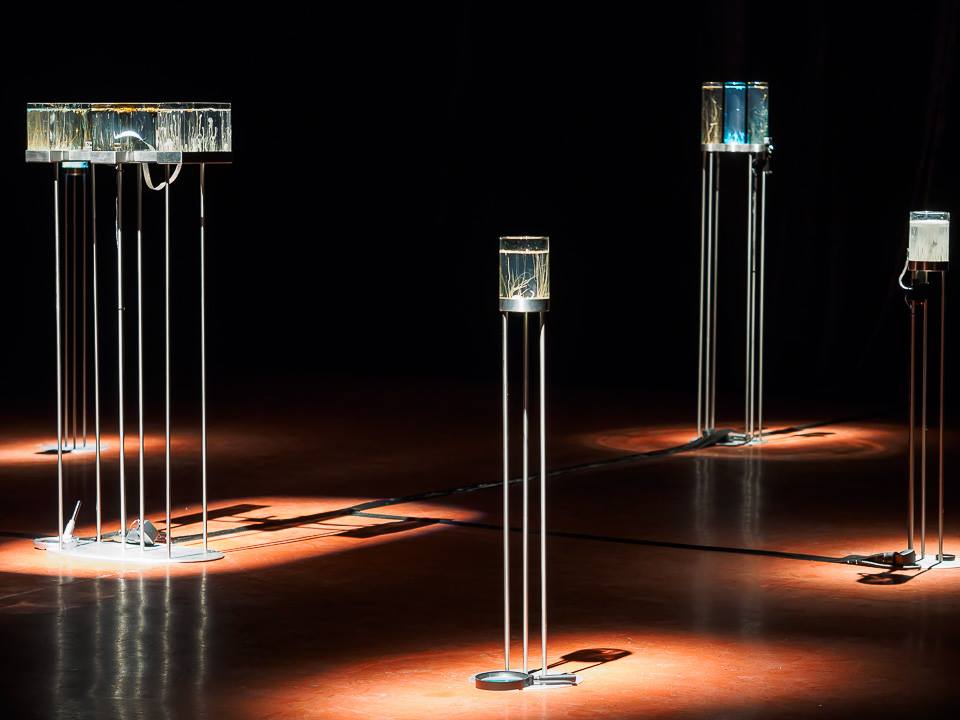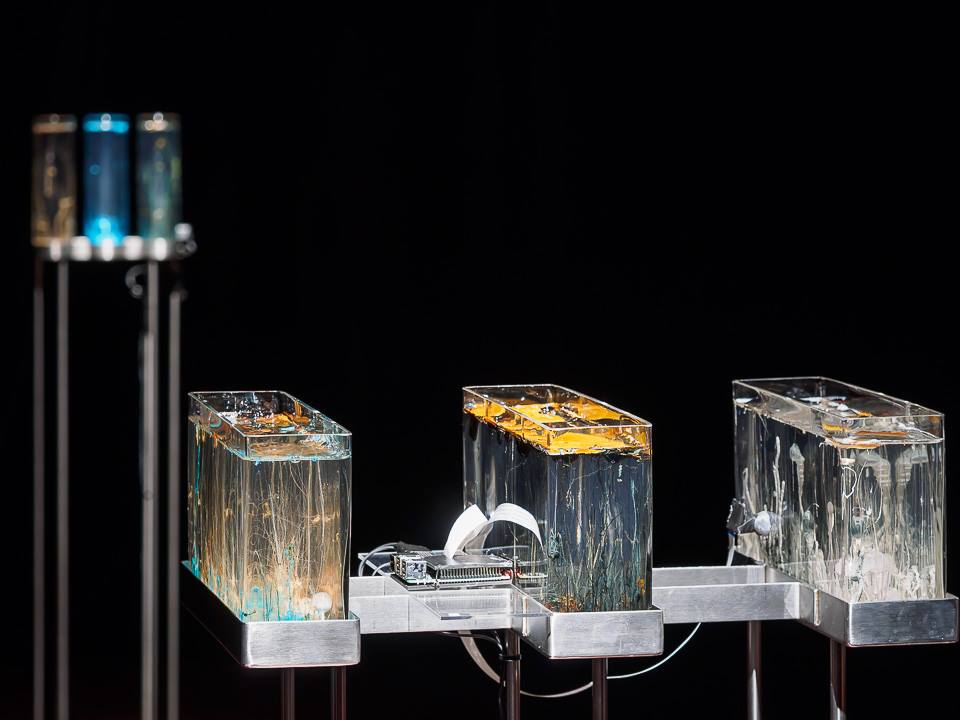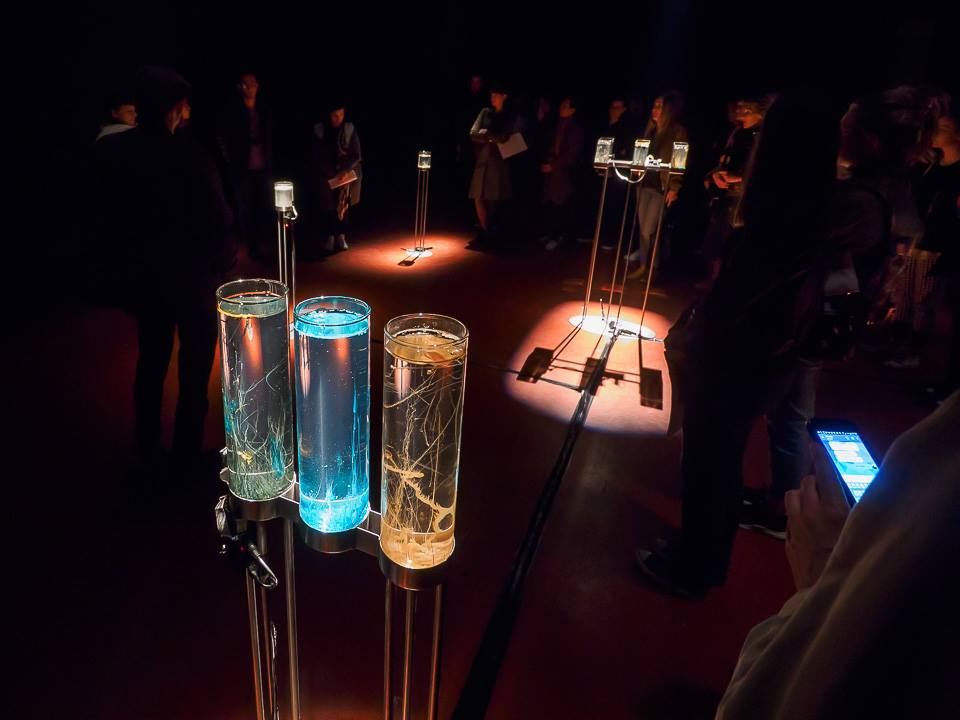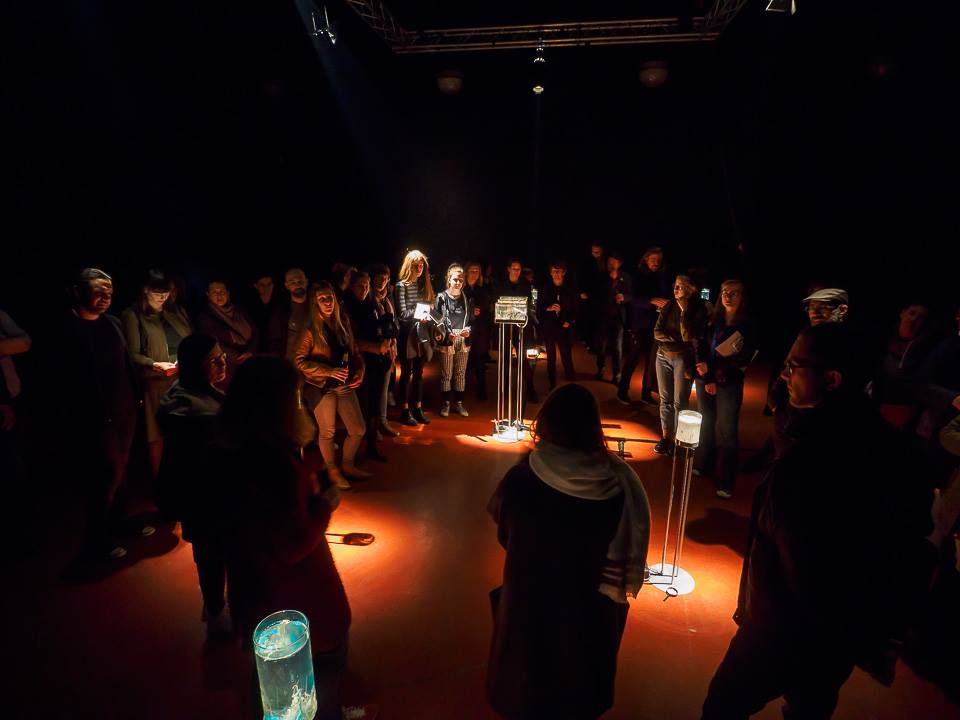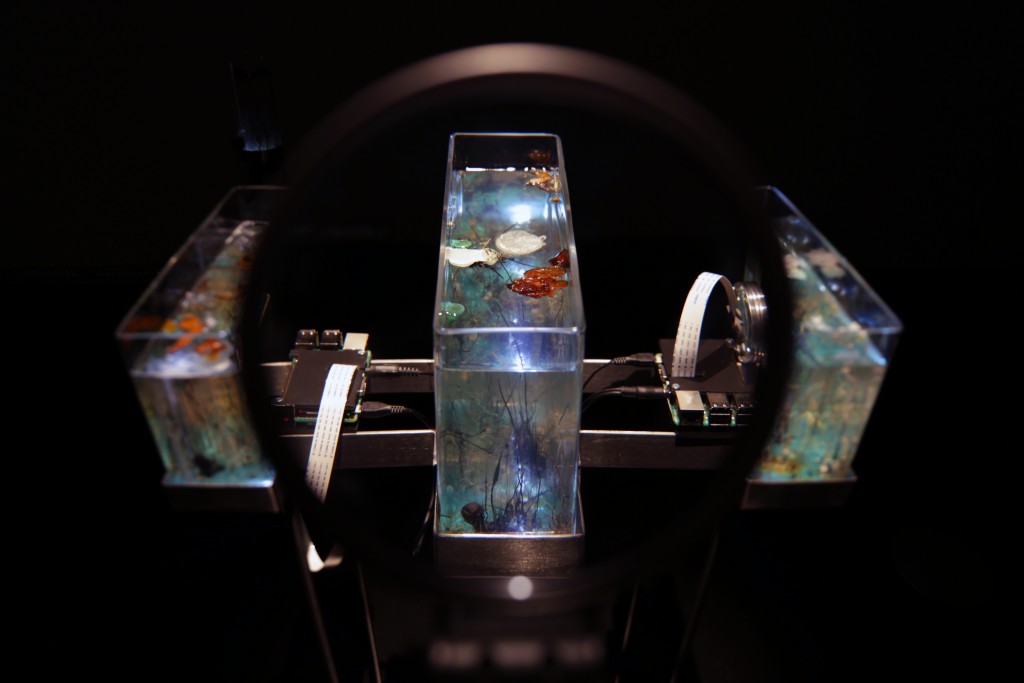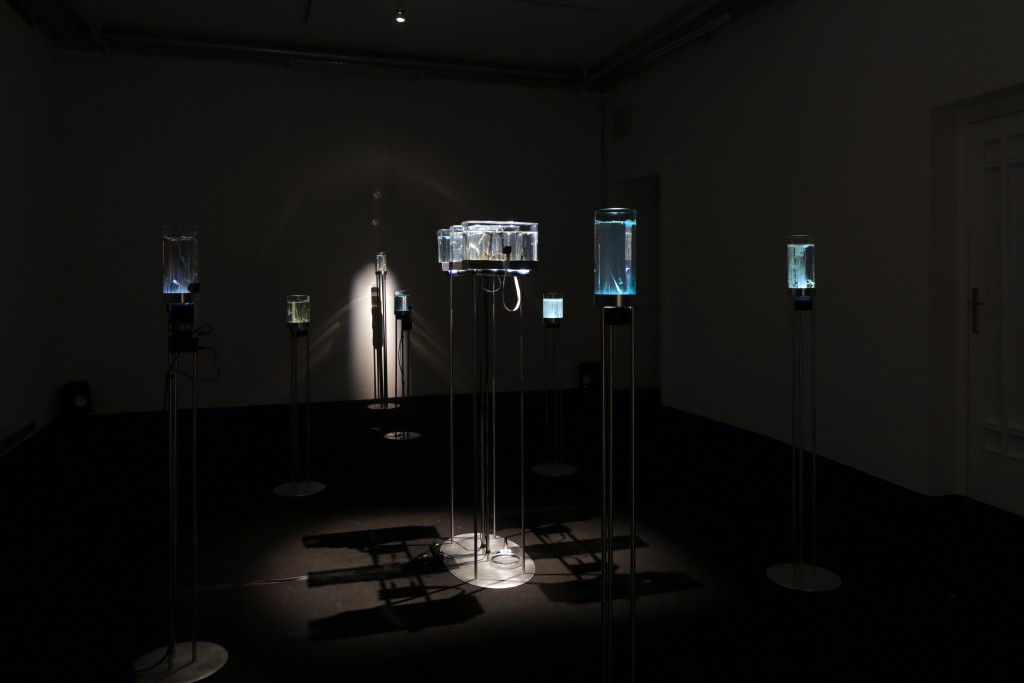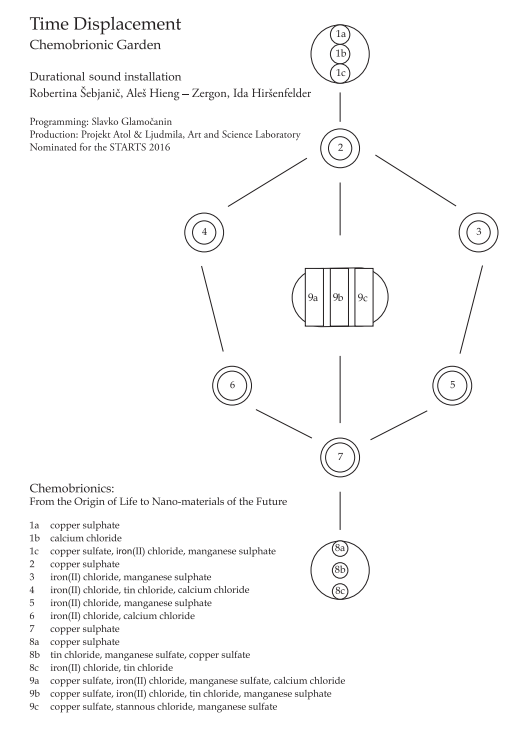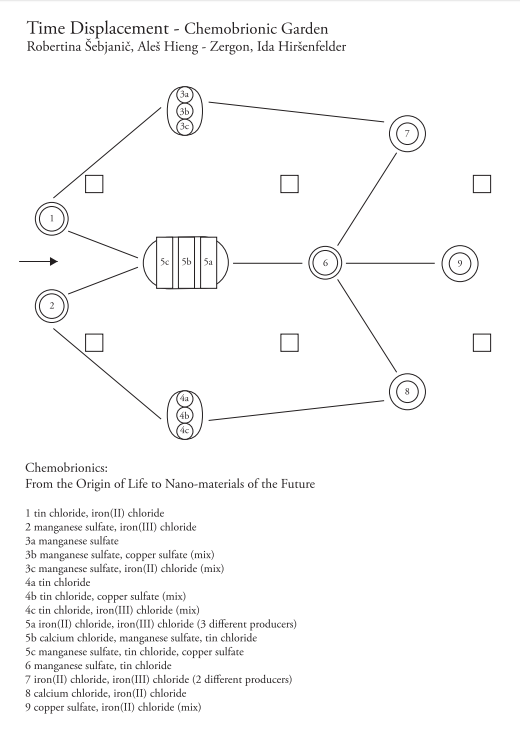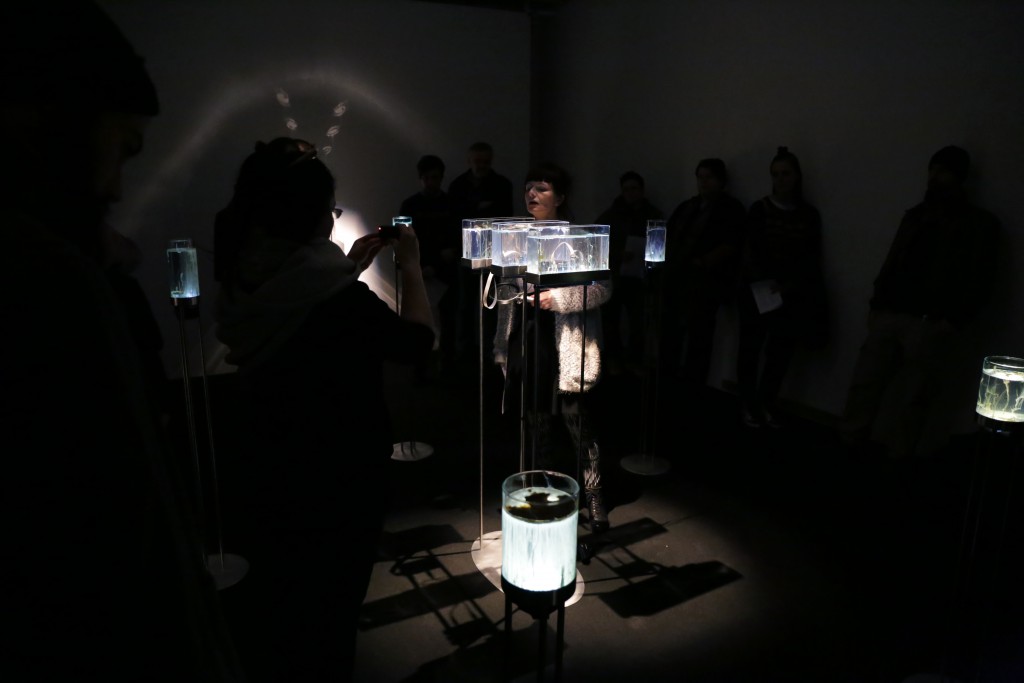Time Displacement / Chemobrionic Garden
interactive generative (chemical) sound installation
Durational interactive performance | sound installation | open laboratory
by Robertina Šebjanič, Aleš Hieng – Zergon, Ida Hiršenfelder
Časovni zamik / Kemobrionični vrt [slovenski tekst ⇊⇊]
„In crystal we have a pure evidence of the existence of a formative life principle, and although in spite of everything we cannot understand the life of crystals – it is still a living being.” (Nikola Tesla, 1900)
Time Displacement / Chemobrionic Garden is an interactive generative chemical sound installation. The installation explores a relationship between hydrothermal chemistry, the passage of time, and sensory systems tracing changes outside of the human scale.
Artists created an installment comprised of several small chemical garden formations in a water glass (sodium metasilicate) solution, to provide an insight into research on the origin of life and on chemical processes. The project’s theoretical background is based on a paper entitled From chemical gardens to chemobrionics, written and issued by a group of 21 distinguished scientists on 29 May 2015, a reiterating call for research into the principles of self-assembling structures, to produce – as they suggest – new insights into the origin of metabolism in Earth’s early geological periods.
The chemical reactions are monitored by cameras to detect changes in colour and in shape by means of a microcontrollers. The changes affect the code for live sound generation, and slowly work to alter the generative drone composition pervading the gallery space. It goes beyond the human perception of time. It calls for a perspective that considers multiple dimensions of temporal rhythms in space with slow modulation beyond the spectrum audible to the human ear.
The core proposition of this piece is to create a situation in which the growth of chemical structures takes the centre stage. The human expectations are put in the background in order to stimulate a state of altered listening in which one is exposed to the geological passage of time.
The antagonism between the human and the Earth’s processes is a direct result of anthropocentric perspective. In the age of anthropocene we need a radical shift in perspective if we are to survive as a species. Scientists are on a new quest to find in these abiotic formations the root of biotic protocells. In addition, Time Displacement poses a question of giving way to life by means of shifting ways of sensing. The question of the origin of life inevitably seeks to ask the question of finite nature of life forms themselves. The colourful biomimetic morphologies of chemical gardens are a fascinating imitation of life. In the last few centuries, chemical gardens have progressed from being a counterfeit of biotic life to being the original; from childlike imitations of life to the sheer origin of life on Earth.
The colourful biomimetic morphologies of chemical gardens are a fascinating imitation of life. Key to these marvellous structures, which spent decades, locked away in an alchemist’s cabinet of curiosities, is a renewed study of chemobrionics, a field combining chemistry, physics, biology, and materials science. Chemobrionics denotes self-propagation, the growth of chemical structures with a tendency to increase concentration gradients under conditions of osmotic pressure and buoyancy. Scientists are on a new quest to find in these abiotic formations the root of biotic protocells. Therefore, in the last few centuries, chemical gardens have progressed from being a counterfeit of biotic life to being the original; from childlike imitations of life to the sheer origin of life on Earth.
Time Displacement is a durational performance which uses chemical gardens as stained glass pictures to explore the optics that change the cultural perception of the world and the practice of differentiating between organic and inorganic matter. This changed perception of matter is made possible by means of interdisciplinary research, which contributes to a more holistic understanding of (geological, chemical, social, political) processes in the world. Although not a new exploration, chemical gardens are only now emerging as an unexpected research area and a prime example in chemistry of self-organising non-equilibrium processes that create complex structures, combining chemistry, fluid dynamics, and materials science. If research in the field of chemobrionics is legitimated by the development of new materials for commercial purposes, Time Displacement encourages such study of materials, which maintains a fascination with the potential development of nanomaterials without any commercial implications.
A durational performance in an open laboratory takes the viewpoint of the history of science to talk about findings, which are primarily a product of the cultural environment not just a result of meticulous research.
The chemical-acoustic live experiments in the installation are comprised of several small chemical garden formations in a water glass (sodium metasilicate) solution, to provide an insight into research on the origin of life and on chemical processes, which unfold at a pace that is rapid, yet still too slow to be discernible to the naked eye. The chemical reactions, where visible changes take between 8 and 48 hours, are monitored by cameras to detect changes in colour and in shape by means of a microcontroller. The changes affect the code for live sound generation, and slowly work to alter the generative drone composition pervading the gallery space. A sound art installation which goes beyond the human perception of time calls for a perspective that considers the multiple dimensions of temporal rhythms in space.
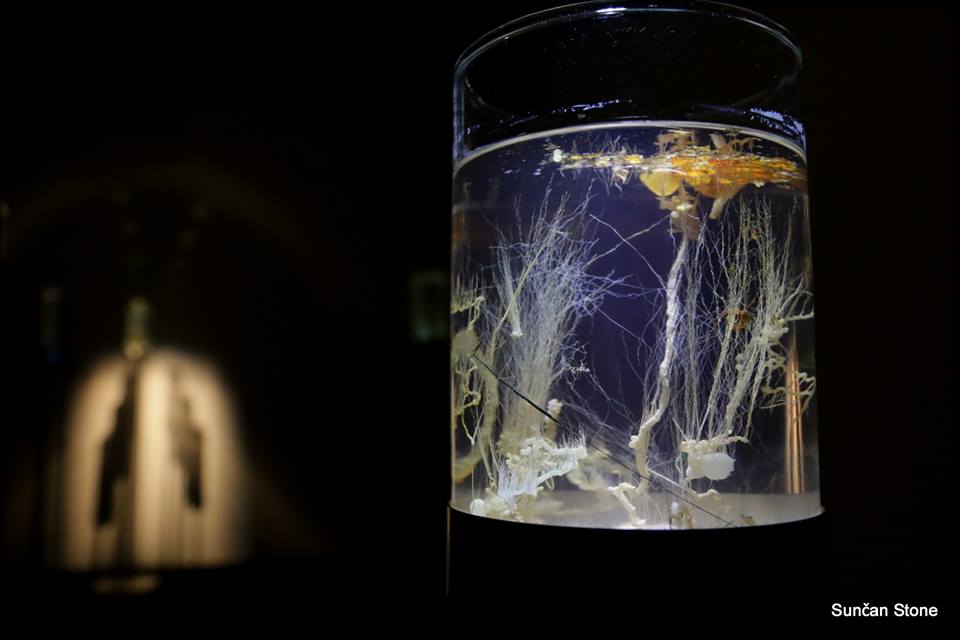 photo by Sunčan Stone
photo by Sunčan Stone
__________________________________________________________________________________________________
The project Time Displacement / Chemobrionic Garden got a nomination STARTS 2016!
It was selected from 1,861 projects into top 30 project of STARTS 2016 award.
more: https://starts-prize.aec.at/en/winners/
__________________________________________________________________________________________________
Project Time Displacement / Chemobrionic Garden is mentioned in a featured story at NASA’s Astrobiology Institute site
http://nai.nasa.gov/articles/2016/2/5/from-chemical-gardens-to-life-and-art/
__________________________________________________________________________________________________
*Chemobrionics is a neologism for interdisciplinary exploration of brionics, merging different fields of science like chemistry, physics, biology and material science. The term was first proposed in From chemical gardens to chemobrionics paper, published on 29 May 2016, signed by 21 renowned scientists from all around the world.
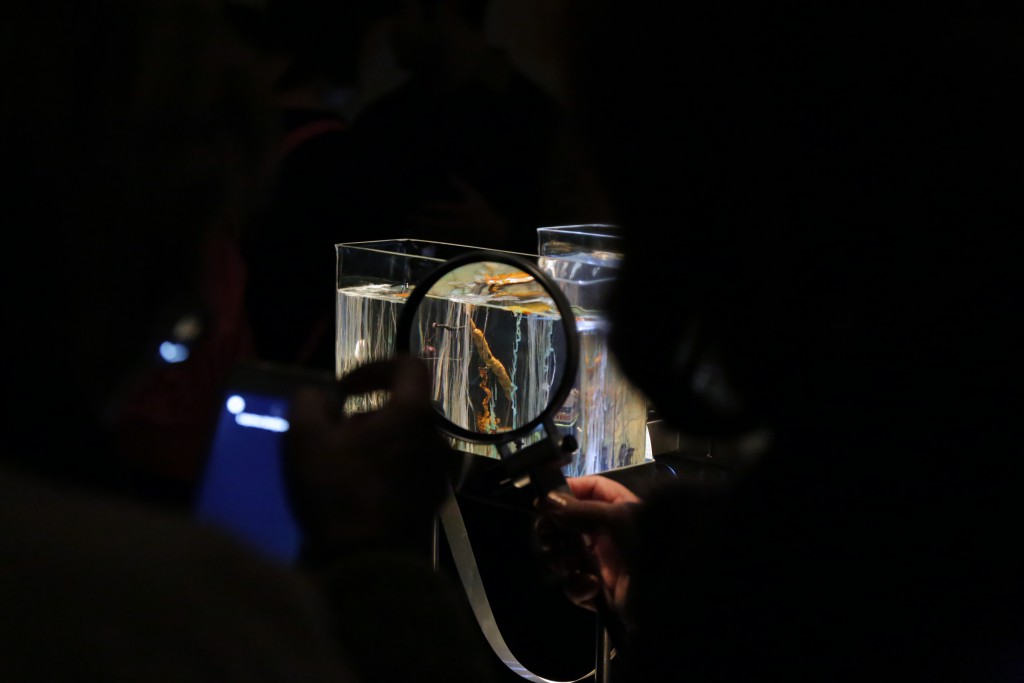 photo by Katra Petriček
photo by Katra Petriček
__________________________________________________________________________________________________
Authors of a project: Robertina Šebjanič, Aleš Hieng – Zergon and Ida Hiršenfelder
Programming: Slavko Glamočanin
Production: Projekt Atol & LJUDMILA, 2015
__________________________________________________________________________________________________
premiere of the project was in December 2015 at Aksioma:
Technical support: Valter Udovičić and Roman B.
Production: Projekt Atol & LJUDMILA, 2015
Partner: Aksioma
Special thanks: Aksioma team and SCCA, Zavod za sodobno umetnost – Ljubljana
Project production was supported by the Slovene Ministry of Culture and MOL – Department for Culture.
more photos:
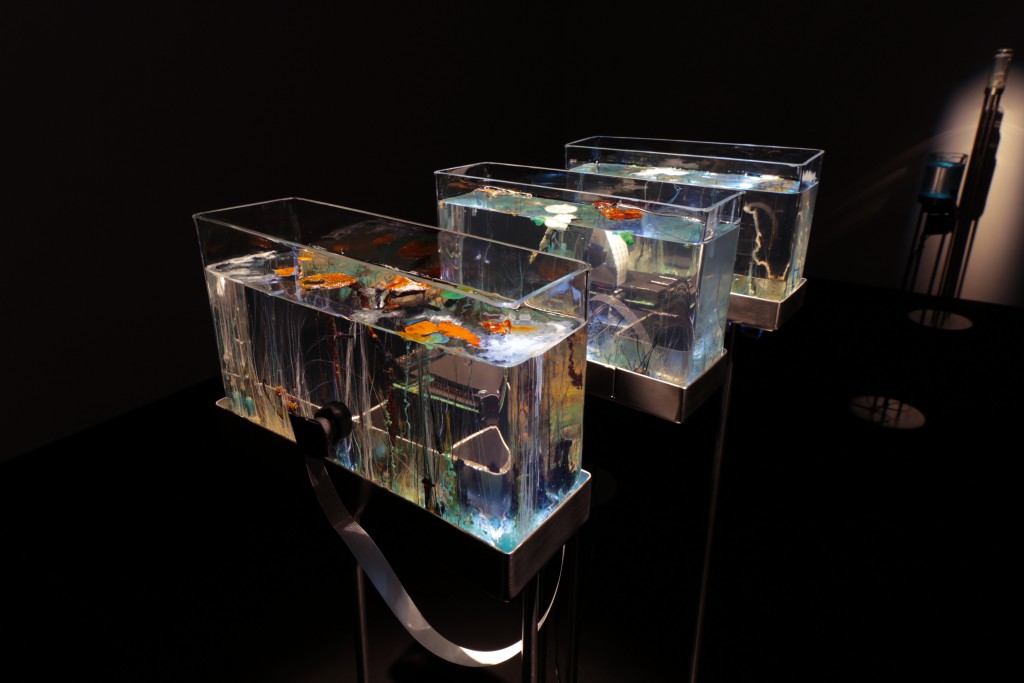
photo by Katra Petriček

photo by Sunčan Stone

photo by Sunčan Stone
__________________________________________________________________________________________________
More about the history of chemical gardens
The history of chemical gardens has always been closely intertwined with experiments juxtaposing the propagation of forms in chemical reactions with biological forms. In the early 19th century, scientific research attempted to prove that biological life had evolved from the inorganic worlds of physics and chemistry: from chemical gardens and osmotic forces, from diffusion and other physical and chemical mechanisms. Scientists’ endeavours in plasmogeny and synthetic biology were refuted when, in the 20th century, genetics established the complexity of hereditary cells by isolating DNA. In the 21st century, on 29 May 2015, a group of 21 distinguished scientists issued a paper entitled From chemical gardens to chemobrionics, reiterating a call for research into the principles of self-assembling structures, to produce– as they suggest – new insights into the origin of metabolism in Earth’s early geological periods.
__________________________________________________________________________________________________
installment plan at Ars Electronica 2016, Radical Atoms Exhibition, Postcity Bunker – Linz, AT
installment plan at Kontejner.org – Pogon Jedinstvo Hall, Zagreb, HR
time-displacement-kontejner-handout
installment plan at Simulaker Gallery, Novo Mesto, SI
time-displacement-simulaker-handout
installment plan at Aksioma Project Space, Ljubljana, SI
time-displacement-aksioma-handout
__________________________________________________________________________________________________
Programme of the premiere exhibition between the 17th till 19th December 2015 at Aksioma project space:
Chemobrionics: From the origin of life to nanomaterials of the future – lecture by Ida Hiršenfelder
The lecture employed the methods of a botanic garden tour. It was based on From chemical gardens to chemobrionics, a paper from May 2015 which restores the role of chemical gardens at the outset of synthetic biology. The scientists publishing the paper suggested the term chemobrionics, blurring the boundaries between inorganic and organic chemistry, and proposing a number of methods for the study of new materials. In the lecture, the frames of reference for an interpretation of Time Displacement included a criticism of science, an analysis of live-generated visual auditory structures, and science fiction.
Lecture by Ida Hiršenfelder, photo by Katra Petriček
Open laboratory by Aleš Hieng – Zergon and Robertina Šebjanič:
The durational performance in an open laboratory has been designed for the general public and scientists to learn about the principles of osmotic forces and crystal growing procedures. In the laboratory, visitors had been able to conduct an osmosis experiment in a water glass solution, with chemical compounds such as sodium silicate, sodium acetate, calcium chloride, copper(II) sulphate, iron(III) chloride, chromium(II) chloride, iron(II) sulphate, cobalt(II) chloride, potassium aluminium sulphate, manganese(II) chloride, nickel(II) sulphate. The audience also learned about live-generated music with slow modulation beyond the spectrum audible to the human ear.
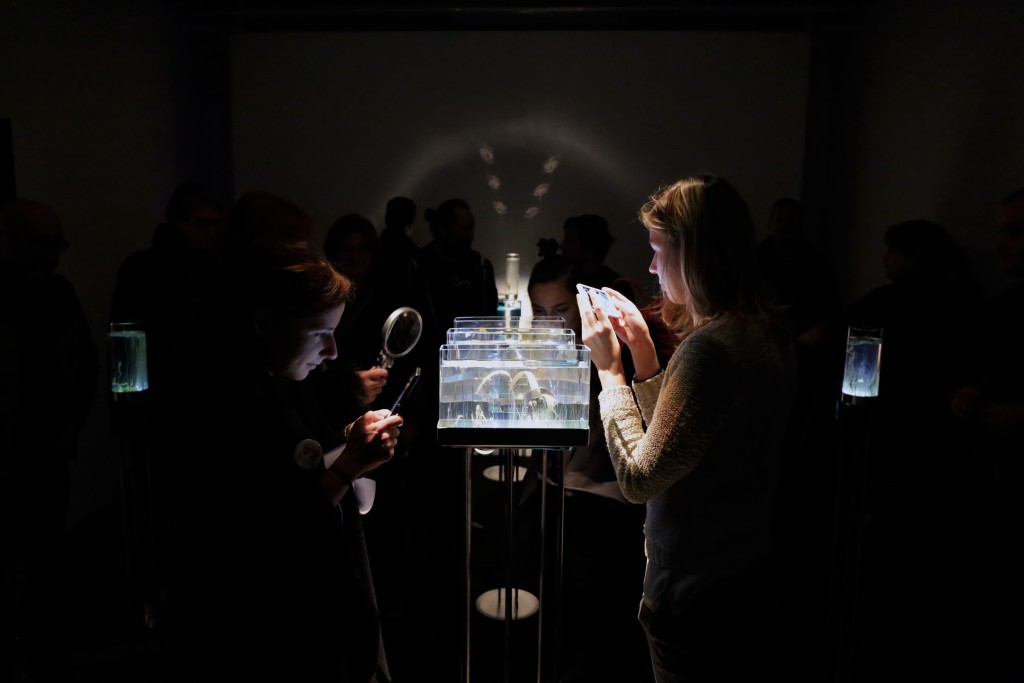
photo by Katra Petriček
__________________________________________________________________________________________________
__________________________________________________________________________________________________
ČASOVNI ZAMIK / KEMOBRIONIČNI VRT
VZTRAJNOSTNI PERFORMANS V ODPRTEM LABORATORIJU
Barvite biomimetične morfologije kemičnih vrtov so fascinantna imitacija življenja. Ključ do teh čudovitih struktur, ki so bile dolga desetletja zaklenjene v alkimistični sobi čudes, je ponovno preučevanje brionike, ki združuje kemijo, fiziko, biologijo in znanost o materialih. Brionika je samorazmnoževanje oziroma rast kemičnih struktur, ki so nagnjene k formiranju vedno večje koncentracije v pogojih osmotskega tlaka in plovnosti. Znanstvenice in znanstveniki v teh abiotskih formacijah ponovno iščejo izvor prototipov biotskih celic. Tako so v zadnjih nekaj stoletjih kemični vrtovi prepotovali pot od imitacije do originala; od otroških ponaredkov življenja do samega izvora življenja na Zemlji.
Vztrajnostni performans Časovni zamik uporablja kemične vrtove kot vitraže za raziskovanje optike, ki spreminja kulturni pogled na svet in ločevanje organske in neorganske materije. Drugačni pogled na materijo omogoča interdisciplinarno raziskovanje, ki prispeva k bolj holističnem pogledu na (geološke, kemične, družbene, politične) procese v svetu. Kemični vrtovi niso nova tema, čeprav se šele danes kaže kot presenetljivo raziskovalno področje in odličen primer samoorganiziranih neuravnoteženih procesov v kemiji, ki ustvarjajo kompleksne strukture in združuje kemijo, dinamiko tekočin in vedo o materialih. Raziskavam na področju kemobrionike daje legitimnost razvoj novih materialov v tržne namene; Časovni zamik pa spodbuja obravnavo materialov, ki ohranja fascinacijo nad potencialom razvojem nanomaterialov brez njihove vpetosti v tržna razmerja. Vztrajnostni performans v odprtem laboratoriju Časovni zamik z vidika zgodovine znanosti govori o dognanjih, ki niso samo rezultat natančnih raziskav, temveč tudi proizvod kulturnega okolja.
Instalacijo, ki je osnova za kemično-akustične eksperimente v živo, tvori več manjših formacij kemičnih vrtov v raztopini vodnega stekla (natrijev metasilikat), ki delujejo kot okna v raziskovanje začetkov življenja in kemične procese, ki se odvijajo hitro, vendar preveč počasi, da bi jih zaznali s človeškim očesom. Na kemične reakcije, pri katerih vidne spremembe nastajajo v razponu od 8 do 48 ur, so usmerjene kamere, ki preko mikrokontrolerja zaznavajo spremembe v barvi in obliki. Spremembe učinkujejo na kodo za generiranje zvoka v živo in počasi spreminjajo sozvočje, ki je vseprisotno v galerijskem prostoru. Zvočenje izven področja človeškega časa kliče po perspektivi, ki upošteva večplastnost časovnih ritmov v okolju.
O zgodovini kemičnih vrtov
Zgodovina kemičnih vrtov je od samega začetka prepletena s poskusi, ki razmnoževanja oblik v kemičnih reakcijah primerjajo z biološkimi oblikami. Znanstvene raziskave iz zgodnjega 19. stoletja so si prizadevale dokazati, da se je biološko življenje razvilo iz neorganskega sveta fizike in kemije: iz kemičnih vrtov in osmotskih sil, iz difuzije in drugih fizikalno-kemijskih mehanizmov. Njihova prizadevanja na področju plazmogeneze in sintetične biologije je ovrgla genetika v 20. stoletju, ko je dokazala kompleksnost dednih celic z izolacijo DNK. V 21. stoletju, 29. maja 2015 je skupina 21. uglednih znanstvenic in znanstvenikov objavila raziskavo Od kemičnih vrtov h kemobrioniki (From chemical gardens to chemobrionics), ter ponovno pozvala k raziskavam zakonitosti samozdruževalnih struktur, ki naj bi bile pripeljale – kot predlagajo – do izvora metaboličnih sistemov v zgodnjih geoloških dobah Zemlje.
Predavanje – Kemobrionika: Od izvora življenja do nano-materialov prihodnosti
Predavanje sledi metodam vodenja po botaničnih vrtovih. Izhodišče je besedilo Od kemičnih vrtov h kemobrioniki (From chemical gardens to chemobrionics), objavljeno maja 2015, ki kemičnim vrtom vrača mesto na začetku zgodovine sintetične biologije. Znanstveniki v besedilu predlagajo neologizem kemobrionika, ki briše meje med neorgansko in organsko kemijo, ter predlaga številne metode za raziskovanje novih materialov. Interpretacija Časovnega zamika je podana z vidika kritike znanosti, analize v živo generiranih vizualno zvočnih struktur in znanstvene fantastike.
Odprti laboratorij
Vztrajnostni performans v odprtem laboratoriju je namenjen laični in znanstveni publiki, ki se z obiskom seznanila z zakonitostmi osmotskih sil in postopki za gojenje kristalnih tvorb. V laboratoriju obiskovalci in obiskovalke preizkušajo delovanje osmoze v solni raztopini s kemičnimi sestavinami kot so: natrijev silikat, natrijev acetat, kalcijev di klorid, bakrov(II) sulfat, železov(III) klorid, kromov(II) klorid, železov(II) sulfat, kobalt(II) klorid, aluminij kalijevega sulfata, mangan di-klorid, nikljev(II) sulfat. Publika se seznani tudi s postopki v živo generirane glasbe, ki se modulira v upočasnjenem času izven spektra, ki bi ga zaznalo človeško uho.
Avtorji: Robertina Šebjanič (robertina.net), Aleš Hieng – Zergon (zergon.org), Ida Hiršenfelder (beepblip.org)
Programiranje: Slavko Glamočanin (naprave.net)
Tehnična pomoč: Valter Udovičić
Produkcija: Zavod Projekt Atol, zanj Uroš Veber in Društvo Ljudmila, laboratorij za znanost in umetnost, zanj Tina Dolinšek
Koprodukcija: Zavod Aksioma
Projekt sta podprla Ministrstvo za kulturo in Oddelek za kulturo Mestne občine Ljubljana.
________________________________________________________________________________________________________________________________________
Photos of the opening in Zagreb at Gallery Močvara, organised by Kontejner, foto- Miran Kramar

